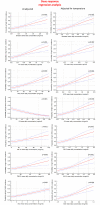Out-of-hospital cardiac arrest and ambient air pollution: A dose-effect relationship and an association with OHCA incidence
- PMID: 34432840
- PMCID: PMC8386838
- DOI: 10.1371/journal.pone.0256526
Out-of-hospital cardiac arrest and ambient air pollution: A dose-effect relationship and an association with OHCA incidence
Abstract
Background: Pollution has been suggested as a precipitating factor for cardiovascular diseases. However, data about the link between air pollution and the risk of out-of-hospital cardiac arrest (OHCA) are limited and controversial.
Methods: By collecting data both in the OHCA registry and in the database of the regional agency for environmental protection (ARPA) of the Lombardy region, all medical OHCAs and the mean daily concentration of pollutants including fine particulate matter (PM10, PM2.5), benzene (C6H6), carbon monoxide (CO), nitrogen dioxide (NO2), sulphur dioxide (SO2), and ozone (O3) were considered from January 1st to December 31st, 2019 in the southern part of the Lombardy region (provinces of Pavia, Lodi, Cremona and Mantua; 7863 km2; about 1550000 inhabitants). Days were divided into high or low incidence of OHCA according to the median value. A Probit dose-response analysis and both uni- and multivariable logistic regression models were provided for each pollutant.
Results: The concentrations of all the pollutants were significantly higher in days with high incidence of OHCA except for O3, which showed a significant countertrend. After correcting for temperature, a significant dose-response relationship was demonstrated for all the pollutants examined. All the pollutants were also strongly associated with high incidence of OHCA in multivariable analysis with correction for temperature, humidity, and day-to-day concentration changes.
Conclusions: Our results clarify the link between pollutants and the acute risk of cardiac arrest suggesting the need of both improving the air quality and integrating pollution data in future models for the organization of emergency medical services.
Conflict of interest statement
The authors have declared that no competing interests exist.
Figures




References
Publication types
MeSH terms
Substances
LinkOut - more resources
Full Text Sources
Medical

